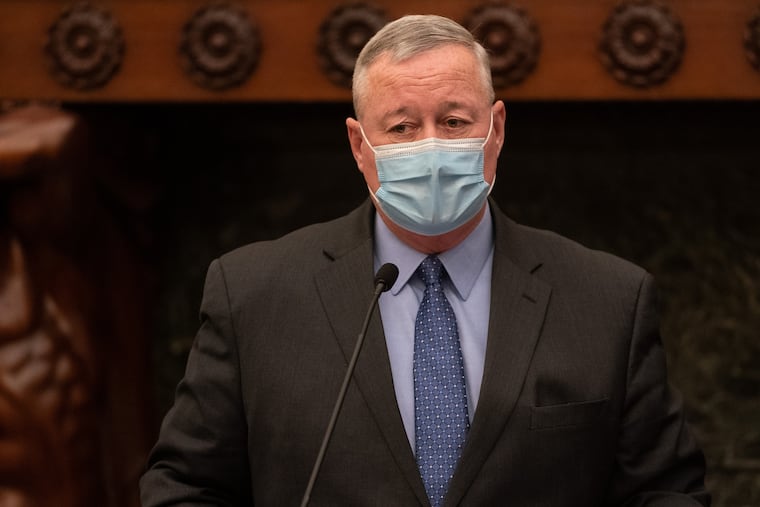Philly’s tax revenues are lower than expected, and costs are up. But overall, the city sees ‘tentative stability.’
Overall, the city described its financial state as one of “tentative stability” in a new report.

The city this year is projected to collect $73 million less in revenue than originally budgeted and spend $103 million more as Philadelphia continues to recover from the economic woes of the coronavirus pandemic, according to the city’s latest financial report.
But the budget, now $5.4 billion, remains balanced, and the city’s projected financial cushion, known as the fund balance, has even grown slightly to $134 million thanks primarily to updated figures for unspent money from last year.
That’s well below the city’s goal of maintaining a fund balance equal to at least 6% of city spending, which would be about $320 million, but it is $47 million higher than the projection included in the budget plan adopted by City Council last June.
The stability of the fund balance is due primarily to the city spending about $220 million less in last year’s budget than anticipated. Budget Director Marisa Waxman said the two main factors driving those savings were wage tax refunds taking a less substantial chunk out of revenue than expected and the city struggling to fill budgeted positions amid a competitive labor market.
Overall, the Quarterly City Manager’s Report, which was released Tuesday and marks the halfway point in the budget year, described the city’s financial state as one of “tentative stability.”
“We’ve achieved more stability and predictability at this point, which is wonderful,” Waxman said.
The mixed bag of financial news comes as Mayor Jim Kenney prepares his proposal for next year’s budget, which begins July 1. His address to Council unveiling the budget proposal, which will be the second-to-last of his administration, is scheduled for March 31.
The top-line numbers showing increased costs and lower revenue belie the amount of factors pulling the city’s coffers in various directions as the economic chaos sparked by the pandemic continues to unfold.
The city, for instance, revised its revenue projection from its 2% sales tax upward by $52 million, to $268 million for the year, thanks to strong collections in the first half. But Waxman said she is wary that the increase will last because some factors driving it may prove to be fleeting. The federal child tax credit program that expired in December, for instance, temporarily increased families’ spending money. Additionally, rapidly rising rents could cut into many Philadelphians’ expendable income.
“We’re pretty jazzed about the really robust sales tax collections that we’re seeing, but we’re also going to continue to really monitor that,” she said.
Meanwhile, the wage tax, which is the city’s largest revenue source, remains a wildcard, It’s unclear how much the shift to working from home will cut into revenue collected from people who live in the suburbs and no longer commute to the city.
The city originally projected collecting $1.55 billion from the tax, which is 3.8398% for city residents and 3.4481% for those who work in Philly but live outside the city. (The rate for Philadelphia residents includes a 1.5% levy collected by a state agency to repay bonds it issued on behalf of the city.)
The administration now expects to take in about $55 million less from the wage tax and faces uncertainty over how companies will handle their suburban employees who work from home some days and commute to the city on others. If many are withholding money from employees’ paychecks as if they were working in Philadelphia full time, the city could be on the hook for millions in tax refunds at the end of the year.
“The shift to remote and hybrid work adds uncertainty to the historically predictable wage tax, as many employers opt to continue withholding and remitting funds through the year with the intention of employees seeking wage tax refunds later,” the report said.
The relatively stable budget picture and the unexpected savings carried over from last year have allowed the administration to further spread out the $1.4 billion the city is receiving from the federal government thanks to the American Rescue Plan approved by Congress last year.
Originally, the city planned to spend $575 million of the relief money in this year’s budget, but the administration now projects spending only $250 million before the end of June.
The rest of the federal subsidy, which is meant to replace revenue the city is losing due to the pandemic-induced economic downturn, is slated to be doled out over the next three years, with $425 million spent in the 2022-23 budget, $396 million in the 2023-24 budget cycle, and $354 million in the final year.
That shift could make life easier for Kenney’s successor, who will be selected in the 2023 mayoral race.
But in the meantime it could also result in increased spending demands from Council members, many of whom took issue last spring with the administration’s cautious budget plans amid the pandemic and the city’s historic gun violence epidemic.
But despite avoiding doomsday scenarios, Philadelphia’s finances are in worse shape than many peer cities, Waxman said. That’s due in part to its reliance on the highest-in-the-nation municipal wage tax, which took a greater hit amid the vagaries of the pandemic economy than the real estate tax levies that most local governments rely on.
The city’s projected $133.7 million may be enough to balance the books, but it would likely not be enough for the city to weather another emergency, which Tuesday’s report noted “has become the norm in the past two years.”
The Government Finance Officers Association recommends cities maintain fund balances equal to 17% of their budget, which for Philadelphia would be an as-yet-unreachable $900 million.